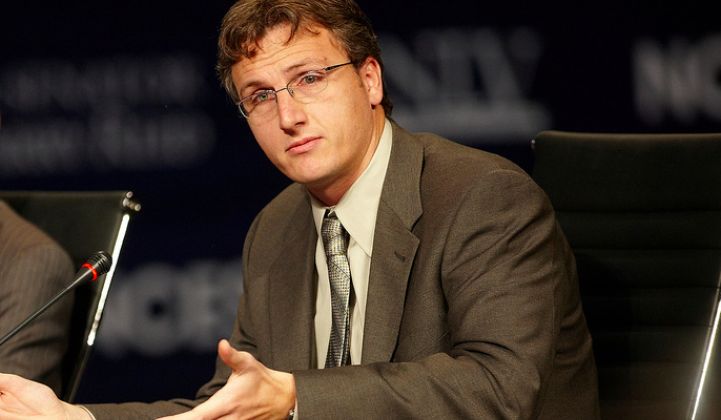Is SolarCity backing away from its Silevo solar cell technology at its Buffalo factory in favor of Panasonic's solar cells? Is the Silevo technology being mothballed?
When SolarCity bought Silevo in 2014 for $168 million in stock and $9 million in cash, the residential solar leader was intent on joining First Solar and SunPower as the third vertically integrated solar company in the U.S. Founded in 2007 by a team hailing from Applied Materials, Silevo had raised $75 million from investors including New Margin, GSR and DT Capital. At the time, Silevo had a $33 million, 32-megawatt production facility in China and production facilities in Fremont, California.
"We will be the most vertically integrated solar company in the world," said SolarCity CTO Peter Rive on a conference call at the time. When SolarCity CEO Lyndon Rive spoke with the Energy Gang two years ago, he viewed the acquisition as a measure preventing against potential industry supply constraints, as well as a source of differentiation. SolarCity had also acquired racking company Zep Solar for $158 million in 2013 as part of its integration strategy.
Silevo's technology achieves higher efficiencies with tunneling junction cells for better junction quality, N-type substrates, thin-film passivation layers that allow higher voltages, and copper-based metal electrodes that eliminate the high cost of silver.
The firm claimed to be producing cells on full-size substrates with efficiencies in the 20 percent to 21 percent range, with "headroom to 24 percent." As we've reported, apart from a few steps in the cell-processing stage, the manufacturing process flow and material requirements closely mirrored those of established crystalline silicon technology.
SolarCity took over Silevo's plans of building a 200-megawatt module factory in New York, intent on scaling those efforts and eventually building a 1-gigawatt factory in the state. According to The Buffalo News, the Empire State would invest more than $225 million into the facilities of Silevo (and LED firm Soraa), with Silevo agreeing to spend $750 million in the region. Such are the aspirational promises made at state-funded energy hub unveilings.
Last year, SolarCity bragged about the module efficiencies it was achieving with the Silevo technology at its pilot plant in Fremont.

But change is afoot in Buffalo, New York.
As GTM's Julia Pyper just reported, "Panasonic has signed a non-binding letter of intent to manufacture solar cells and modules at SolarCity’s factory in Buffalo, New York," in a plant "expected to employ 1,460 workers and produce up to 10,000 panels per day." Panasonic would start making PV solar cells and modules in Buffalo in mid-2017, effectively running the plant with Tesla-SolarCity. In return, Tesla would provide a commitment for Panasonic solar products that will work with Tesla’s stationary battery units.
But now, according to Recharge, "Panasonic has confirmed it would use its own PV technology at a new cell and module factory in New York," adding, "Tesla appeared to suggest that Silevo...would effectively [be] sidelined if the deal works out." SolarCity responded to Recharge via email: “SolarCity/Silevo technology remains an important and applicable component of the end solar module," adding, “Together we will combine the best cell components and integrate them into the new solar module that will be produced in Buffalo, New York.”
Julien Dumoulin-Smith at UBS writes, "While still a pending deal directly with TSLA predicated on SCTY acquisition close, we emphasize the development argues for a potential write-down of the technology. More importantly, this affirms the projections for meaningful further negative cash flows. Lastly, the question persists as to whether there would be any above-market offtake arrangements put in place to support the project development given the glut of global oversupply. Convincing a third-party manufacturer to pursue would appear to need a third-party commitment. Lastly, considerations around NY payments and wider NY state benefits test remains unclear if this obligation will be transferred. This is a non-trivial degradation in a largely non-core business for SCTY, potentially a factor for the Nov. 17 shareholder vote, but unlikely to impact the core [residential] solar biz, in our view."
Despite the vertical integration strategy defended by Lyndon Rive, relinquishing control and ownership of the Buffalo factory to Panasonic might be a positive turn -- eliminating capital risk and technology risk just ahead of the shareholder vote on the Tesla-SolarCity acquisition.
There is also a possibility that the Panasonic partnership could somehow help SolarCity avoid paying Department of Commerce-imposed tariffs on its heterojunction with intrinsic thin layer solar cells made in eastern China, which are then shipped to the U.S. for module processing in Buffalo. The new manufacturing deal could allow SolarCity to benefit from Panasonic’s Japan-based supply chain. However, it’s not clear at present how that partnership would work.
We've asked SolarCity to comment on the future of the Silevo technology but have not yet received a response.
FIGURE: Silevo's Solar Cell Technology



